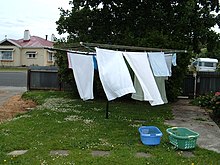Clothes line



A clothesline is a rope on which laundry can be hung to dry . Clotheslines can be placed outdoors, on balconies or patios . When drying clothes in the house, clotheslines are mainly installed in rooms in which the moisture that occurs does not cause any damage, for example bathrooms . Wall-mounted hooks (for indoor and outdoor mounting), trees or posts are used as attachment points for clotheslines. In the case of outdoor installation, the lines are attached at a height of about 1.50 to 2 meters in order to prevent the laundry hanging up to dry from being soiled by touching the floor.
Social
In some regions of the United States , such as California , clotheslines are not popular in residential areas as they are usually associated with poverty and some may feel disturbed by the sight of strange clothes, including underwear; In many places there are bans against (publicly visible) clotheslines. As a rule, people only dry their laundry there using a tumble dryer .
In October 2015, after the commitment of Democratic MP Patty López, a law was passed in California that denies homeowners' associations the right to ban clotheslines. In many of the more than 35,000 housing estates, hanging laundry on balconies and in gardens contradicted the aesthetics of settlements and could be a reason for dismissal. This means that 7 states in the USA support the cheaper, environmentally friendly and hygienic alternative to the electric tumble dryer by law.
In Germany, clotheslines were and are often part of the equipment in apartment buildings. In addition to the outdoor area, attics used to be common places of installation, but this option has often disappeared since many attics have been converted into residential purposes. In the case of the earlier roofs without thermal insulation, adequate ventilation of the attic was usually provided; with the insulation that is common today, it has to be done by opening windows or the like. be ensured. In newer houses, basement rooms that serve as laundry rooms are often equipped with clotheslines.
Various installation options
The high clothesline is a special way of drying clothes using linen . It consists of a rope, which is installed with two rollers at two high fastening points and is accessible from windows or balconies on upper floors. At one of the attachment points, the hanging items of laundry are moved away from or towards the suspension point by manual pulling force. Especially in southern European countries such as B. Italy , such lines were often stretched in narrow old town streets between houses opposite, so that the drying laundry was part of the typical cityscape, as it is often depicted in paintings.
Other common forms of attaching the leash are clotheslines on folding racks such as the clothes horse . These are mainly used in buildings, but also on balconies and terraces .
Outdoors also removable, rotating folding frames (coming clothes dryers ) with clotheslines used.
Different materials
Three variants are common: rubber jacket with a polypropylene core , rubber jacket with a steel core or sisal clothesline.
The individual materials have the following advantages and disadvantages:
- Sisal
- Natural fiber, compostable, possibly visually attractive, if used outdoors, the leash must be removed after use, otherwise it will rot too quickly.
- Rubber jacket + polypropylene core
- Inexpensive variant, visually no difference to steel core, but with the same core diameter less resilient due to the lower tensile strength of polypropylene relative to steel. Further disadvantages compared to steel - especially when used outside: Polypropylene loses its elasticity at low temperatures (from approx. 8 ° C) and becomes brittle due to moisture (risk of cracking).
- Rubber jacket + steel core
- Permanently very resilient and elastic, very well suited for outdoors - but here too the rubber jacket, which protects against corrosion, becomes brittle.
Sometimes plastic-coated wire is used as a replacement material for clotheslines , which is actually intended for use in fence construction . Although this material is very durable, it is more difficult to tension it tightly; special wire tensioners are usually required for this.
Web links
Individual evidence
- ↑ http://orf.at/#/stories/2303557/ California abolishes ban on clotheslines, orf.at, October 10, 2015, accessed October 10, 2015.


